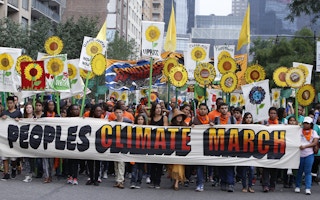Bold action on climate change: that’s what we all wanted to see at Tuesday’s Climate Summit convened by Ban Ki-moon. And a big part of this is about money – money to help developing countries respond to climate change, to capitalise the Green Climate Fund (GCF), and to green the global financial system. Without new finance commitments, we are not going to secure an ambitious global agreement on climate change in Paris next year.
So how bold were the commitments on climate finance? All in all, the U.N. Secretary-General’s office estimates that the summit resulted in a financing package of more than $200 billion from public and private sources. While much more needs to happen before the Lima climate talks in December – particularly in terms of mobilising support to scale up finance for developing countries – this is encouraging progress.
The amount of funding pledged to the Green Climate Fund more than doubled. France promised $1 billion over four years, adding to Germany’s pledge of $1 billion announced over the summer. A mix of countries - including Denmark, Norway, Luxembourg, the Czech Republic and Switzerland - pledged an additional $300 million.
South Korea also pledged $100 million and Mexico $10 million, while other countries showed their willingness to contribute such as Colombia. That reflects the new global nature of a fund that brings both developed and developing countries together as equal partners in the transition to low-carbon and climate-resilient development.
The $2.3 billion pledged so far is still a long way from the fundraising target of $10 billion set by Christiana Figueres, executive director of the U.N. climate change secretariat. And there are some big unknowns: Barack Obama noted that the United States was working alongside others to operationalise the fund, but there is a need for clarity on the scale of the U.S. contribution.
Britain was also silent on the scale of its pledge - David Cameron merely reiterated the $5.92 billion already committed through the UK’s International Climate Fund.
But as Hela Cheikhrouhou, executive director of the Green Climate Fund’s secretariat, noted, these set a positive tone for the official GCF pledging meeting in November. So the New York summit does seem to have catalysed some action, although it’s certainly less than many would have hoped for, four years after the creation of the fund.
Other noteworthy commitments this week included China’s pledge to triple support for South-South cooperation on climate change, and to give $6 million to the U.N. Secretary-General’s office to support developing country learning and collaboration. And the United States announced it will be integrating climate resilience into all of its development assistance.
There were several additional commitments, including more than $500 million to address the vital linkages between forests and climate change. Norway made new bilateral commitments to support Peru with $300 million to protect the Amazon, for the Latin American nation’s efforts to reduce emissions from deforestation and forest degradation (REDD+).
This may not give developing countries the clarity they need on future finance for REDD+, as highlighted in our recent overview of the current state of REDD+ finance. But again, it is encouraging progress.
Greening the financial system
“
Without new finance commitments, we are not going to secure an ambitious global agreement on climate change in Paris next year.
On Monday, thousands of activists occupied Wall Street calling for divestment from fossil fuels.
Soon after in the U.N. building, an investor coalition of the U.N. Environment Programme Finance Initiative, the Carbon Disclosure Project and two of Europe’s largest pension funds committed to divest from $100 billion in fossil fuels, and to begin reporting on the carbon emissions of at least $500 billion in other investments.
The announcement came on the heels of the Rockefeller Foundation’s announcement that it too would be divesting from fossil fuels.
National development banks of the International Development Finance Club (IDFC) and the multilateral development banks announced they are on track to continue increasing their spending on low-carbon and climate-resilient development.
Jim Yong Kim, the president of the World Bank, pointed out that is necessary to maximise global investment in climate-related activities, and that the bank has allocated more than $42 billion for these issues, emphasising that is time to leverage climate finance.
The developed and developing country members of the IDFC announcing that they will be spending $100 billion a year on climate activities by 2015.
Contested Concept
Of course, what counts as “low-carbon and climate-resilient investment” is contested, and without clarity on definitions, it may be all too easy to reach such targets.
The UNFCCC’s forthcoming biennial assessment of climate finance flows to which ODI is contributing will explore some of these questions. And beyond just the money, the real question is how well we use it to make the transition to cleaner and more resilient development.
As ODI’s work highlights, while dedicated public finance may be a small part of the financing picture, it plays a vital role in demonstrating and catalysing shifts in recipient countries. Finding ways that work, and learning from what does not, will be essential to efforts to raise the ambition of developed-country contributions to help developing countries respond to climate change.
The climate summit was a good first step. However, the announcements and commitments made there were not enough respond to the demands made by the hundreds of thousands of people marching for climate action in New York and other parts of the world last weekend.
Smita Nakhooda is a senior research fellow with the Overseas Development Institute. This post was originally published on Thomson Reuters Foundation’s Alertnet.


















